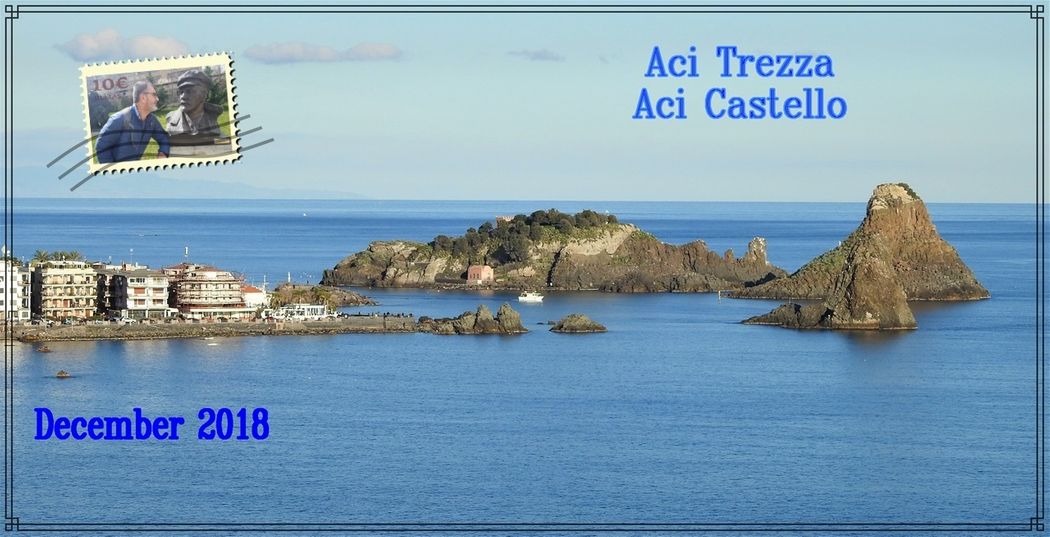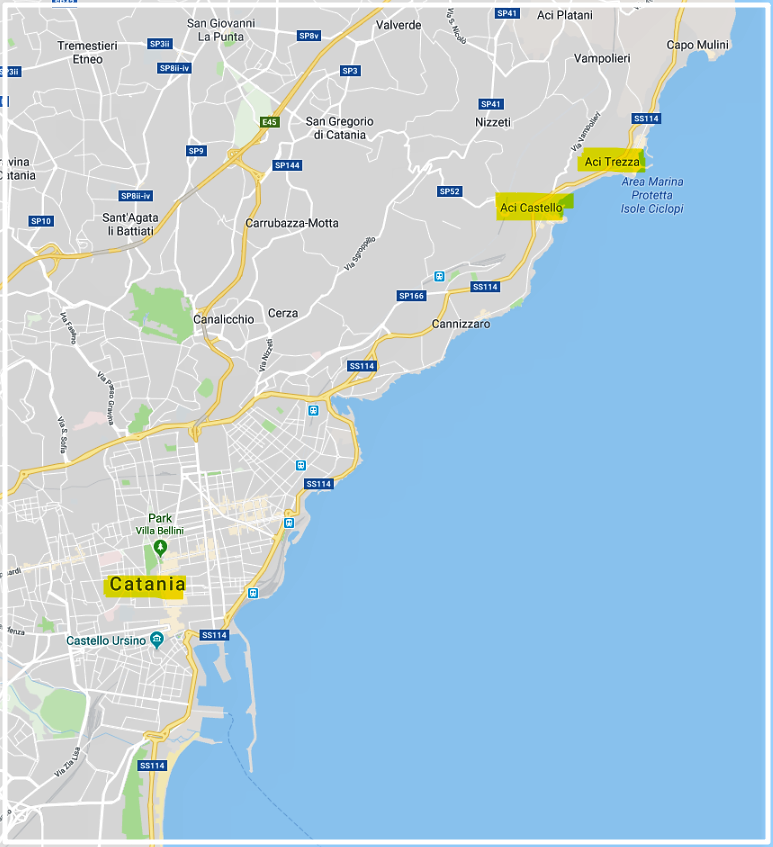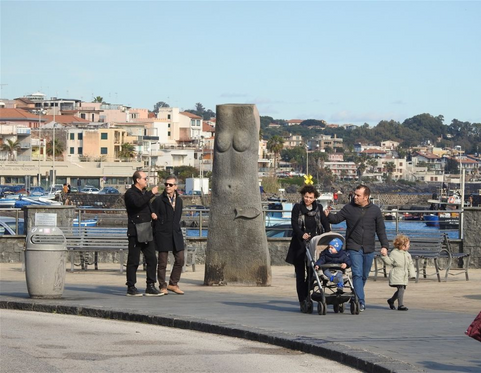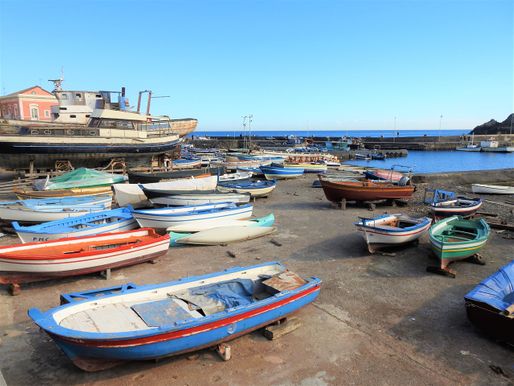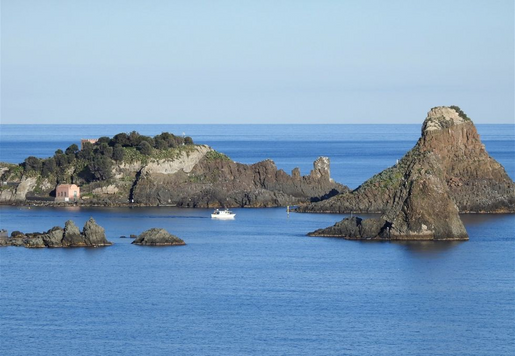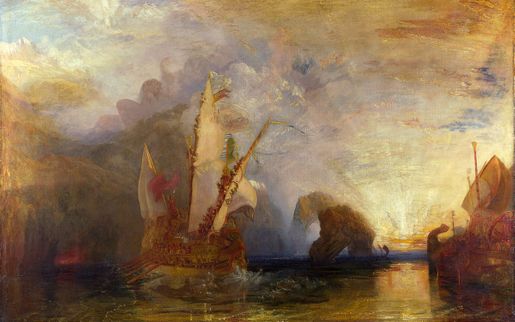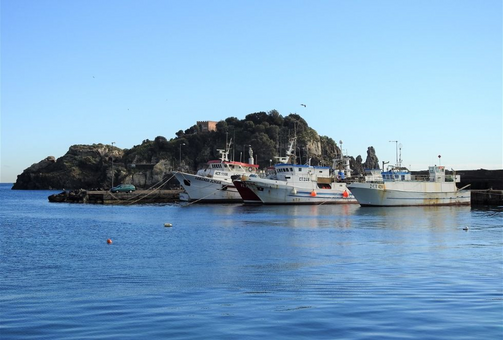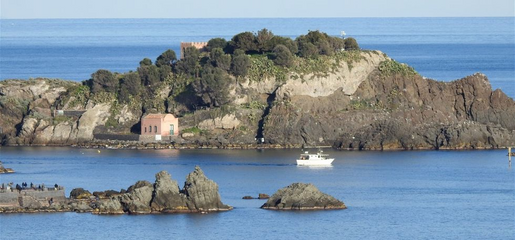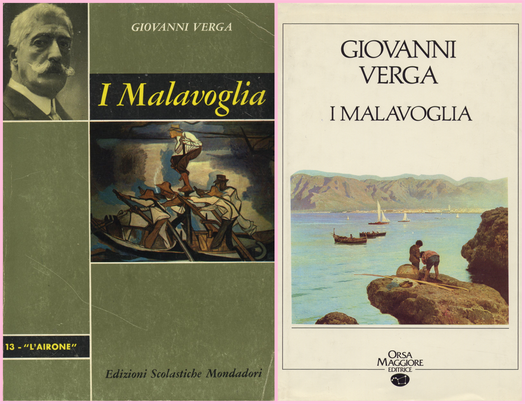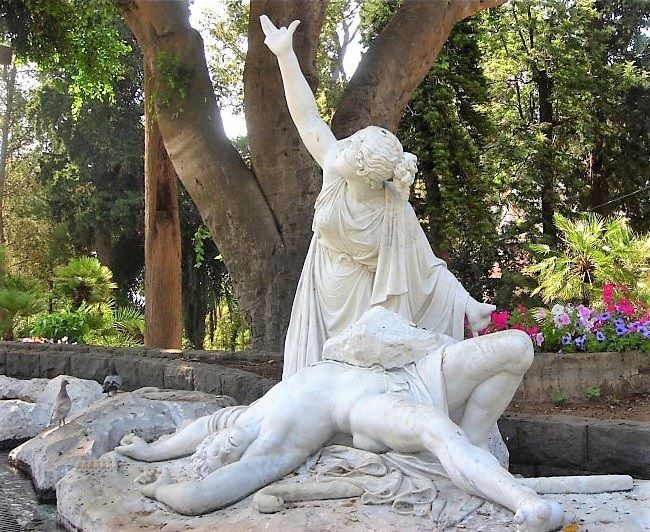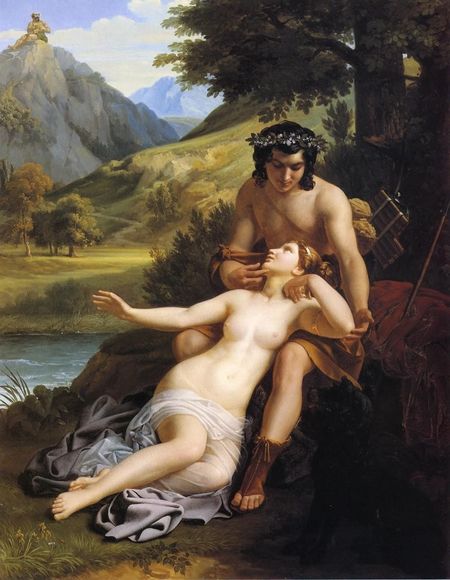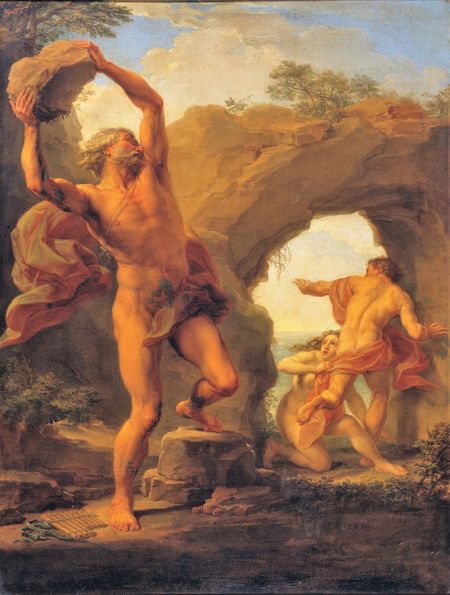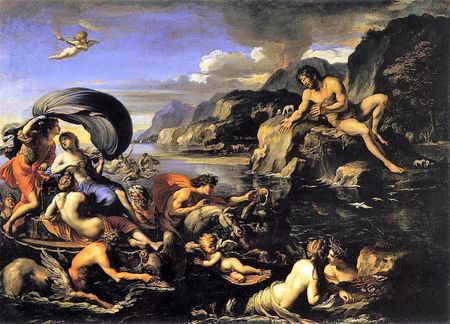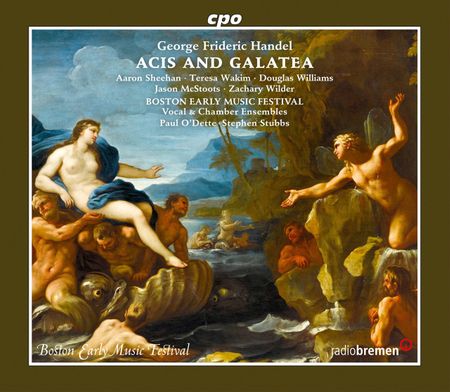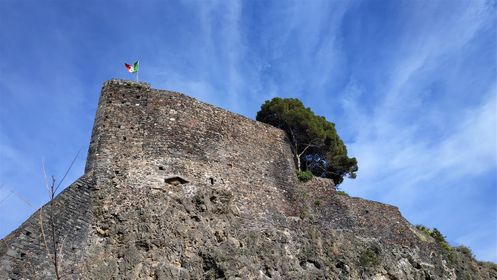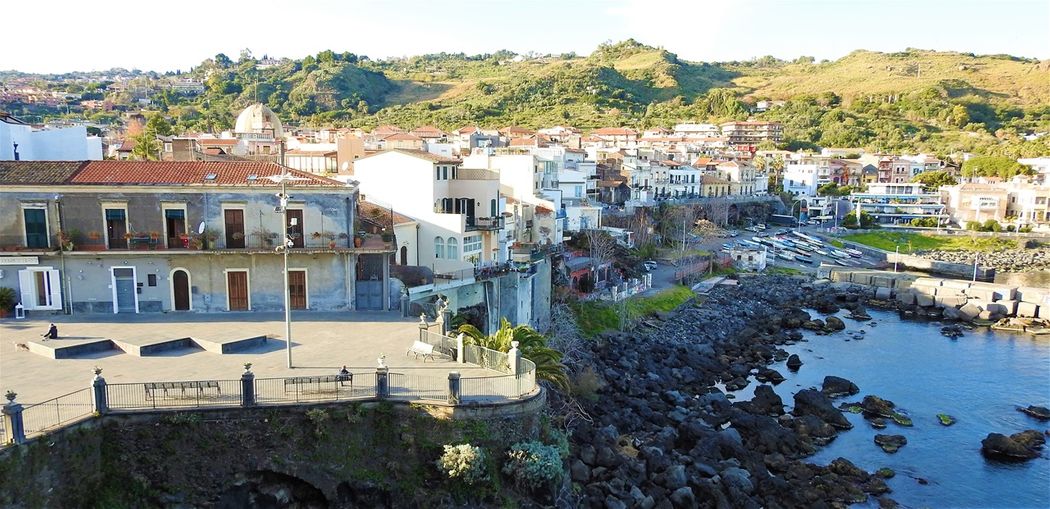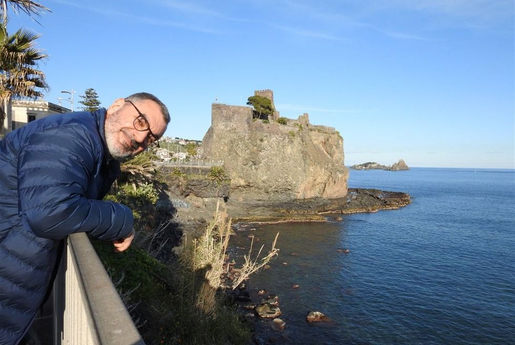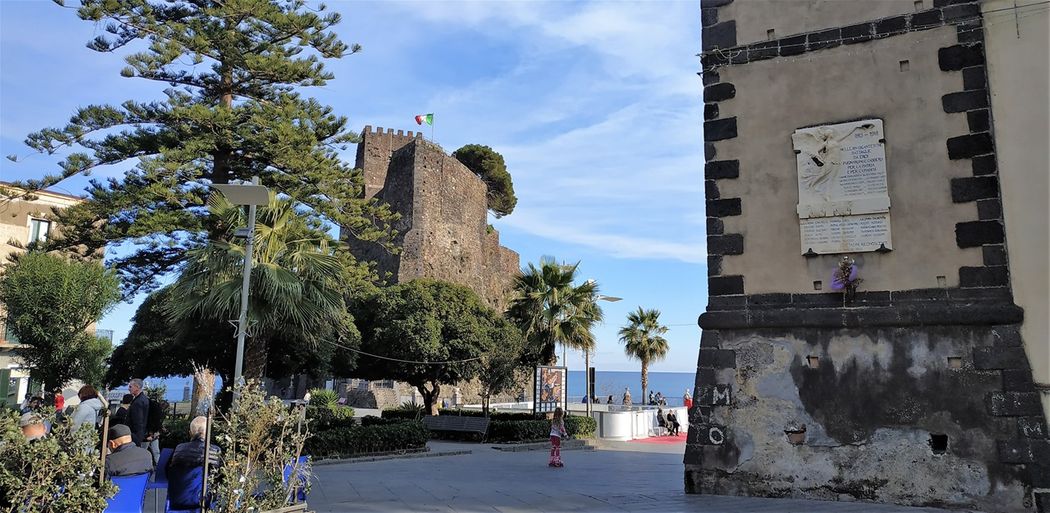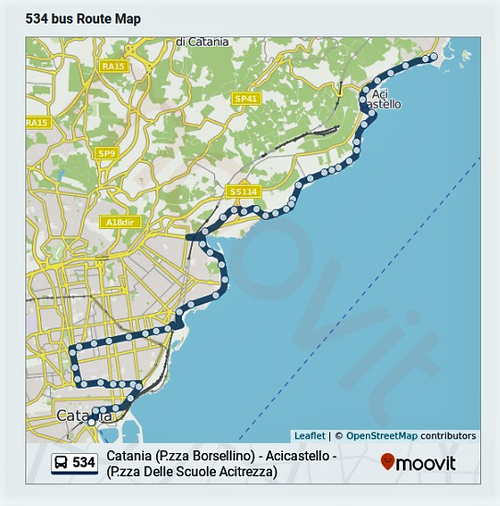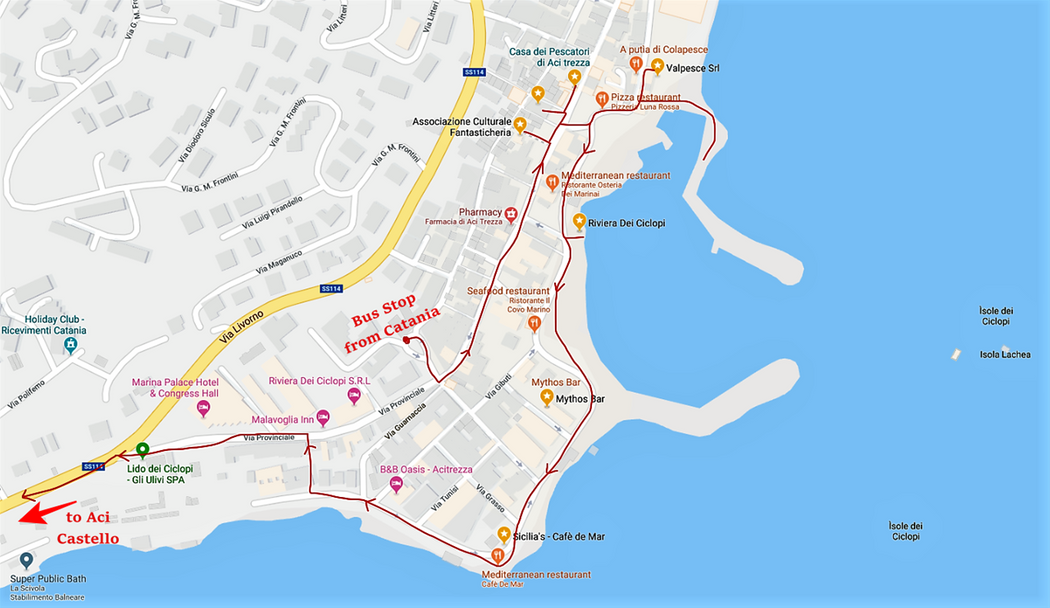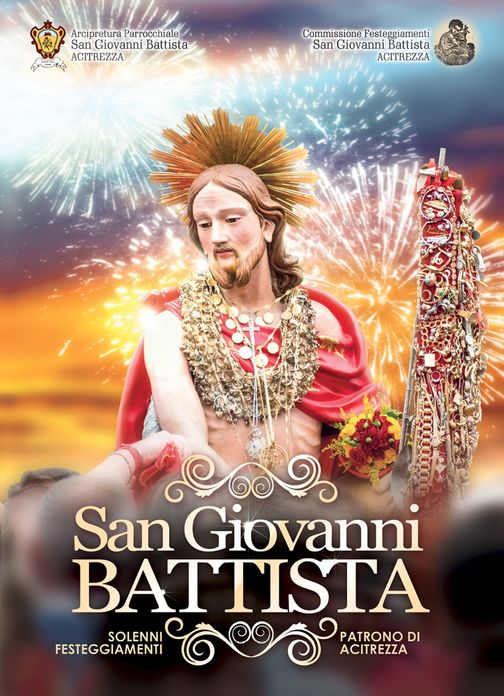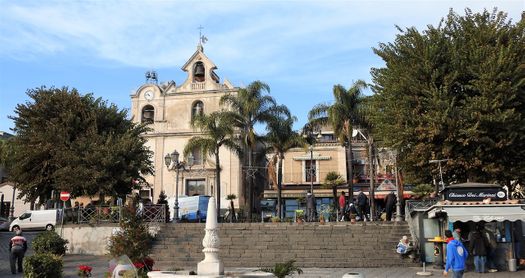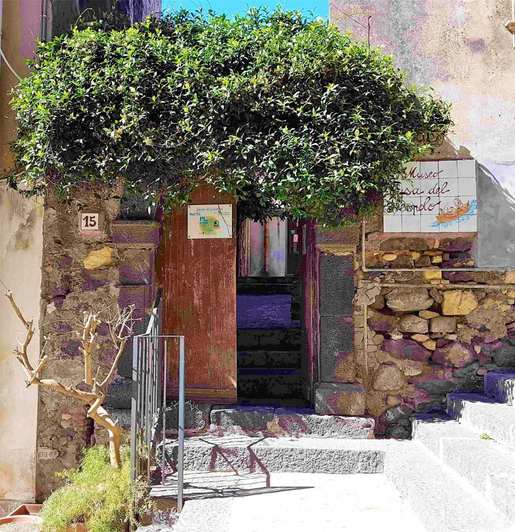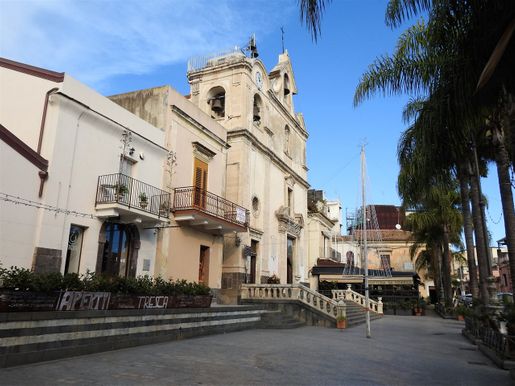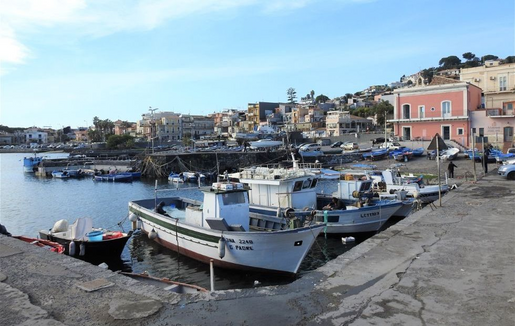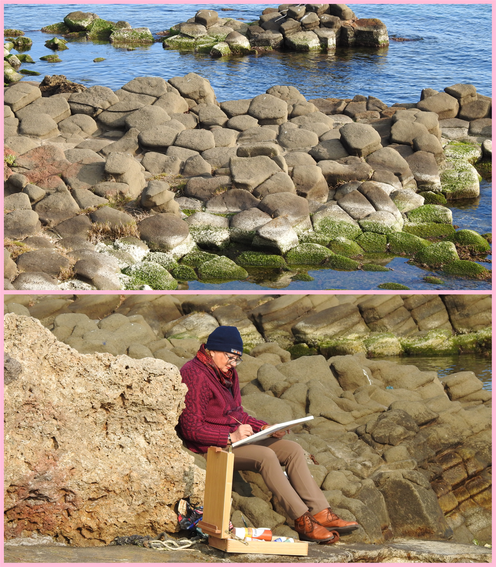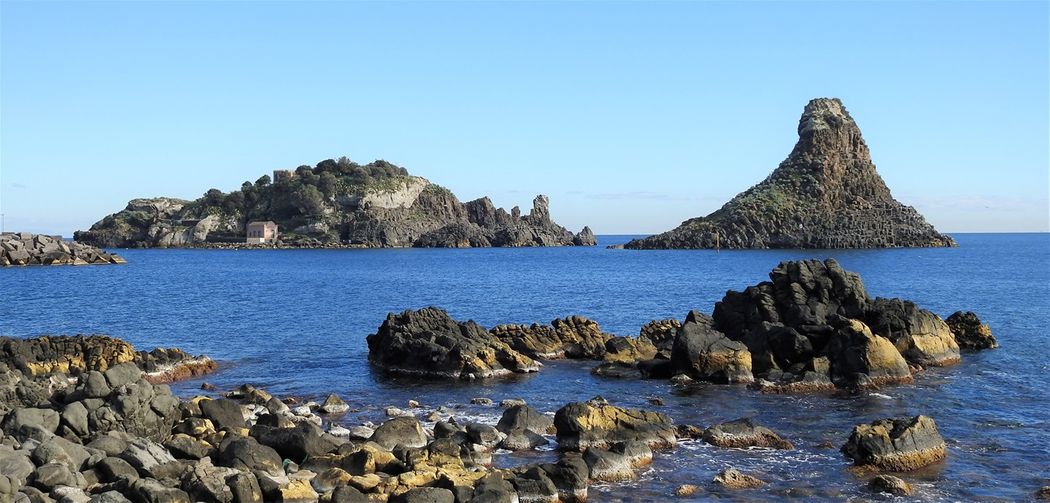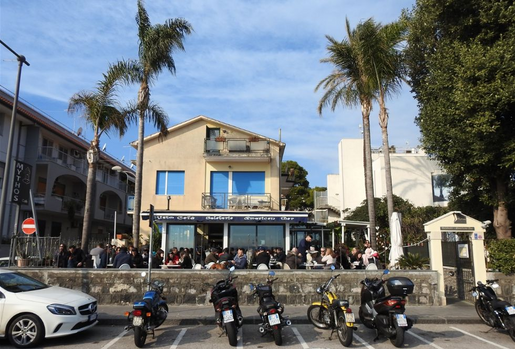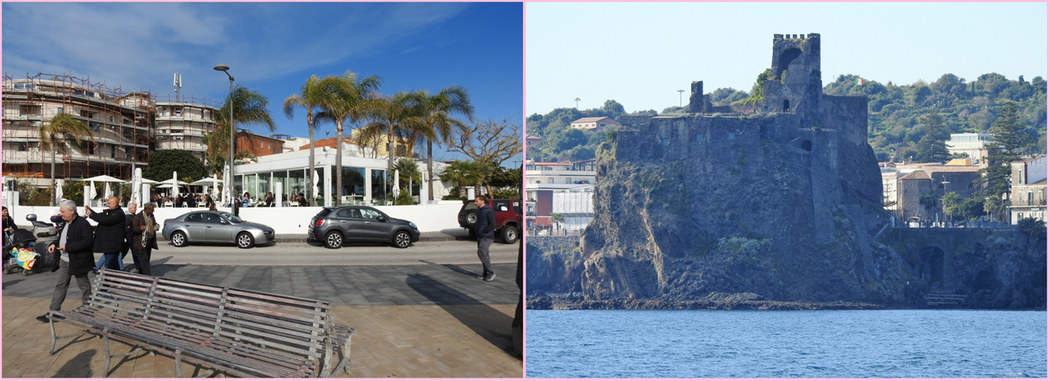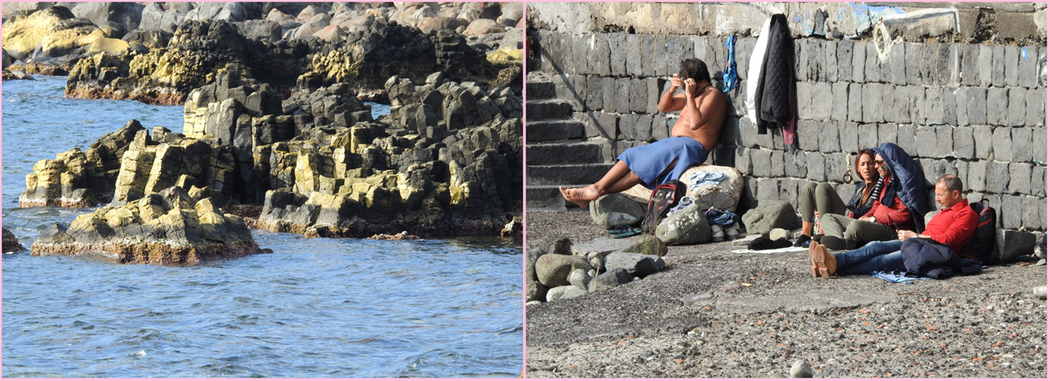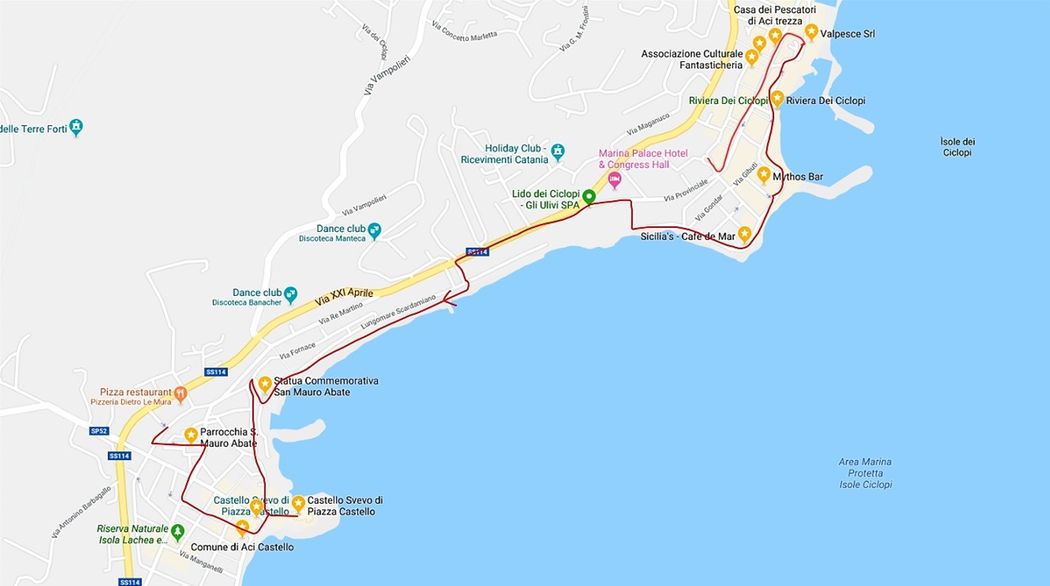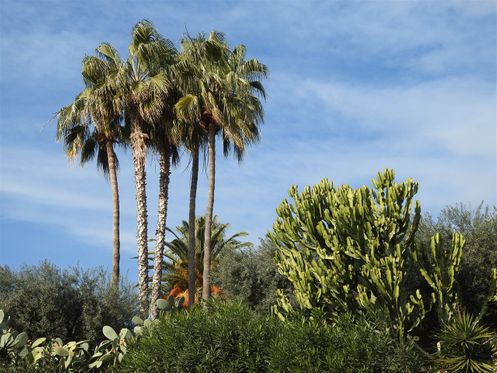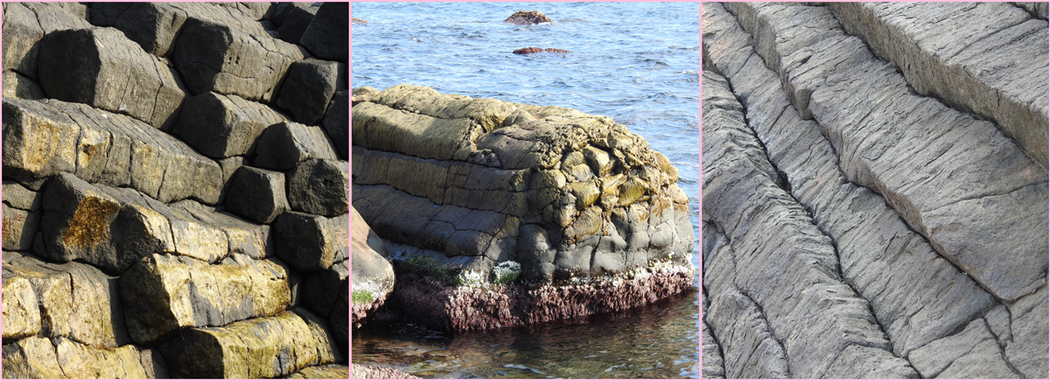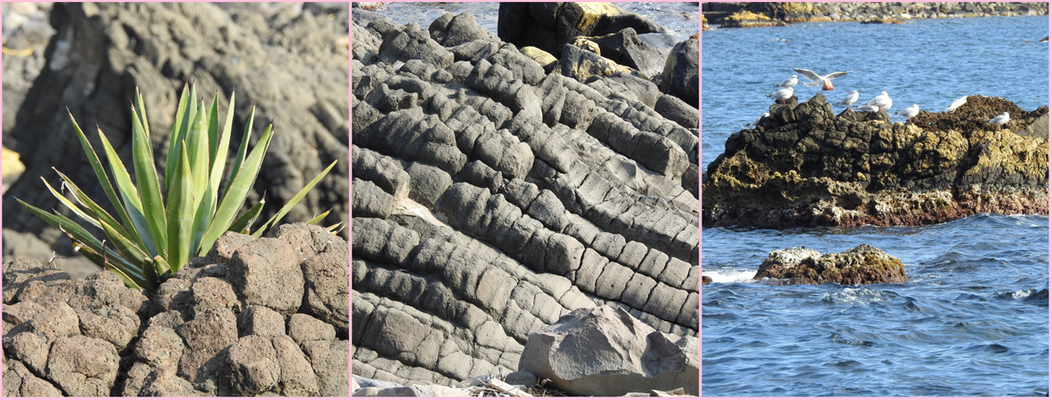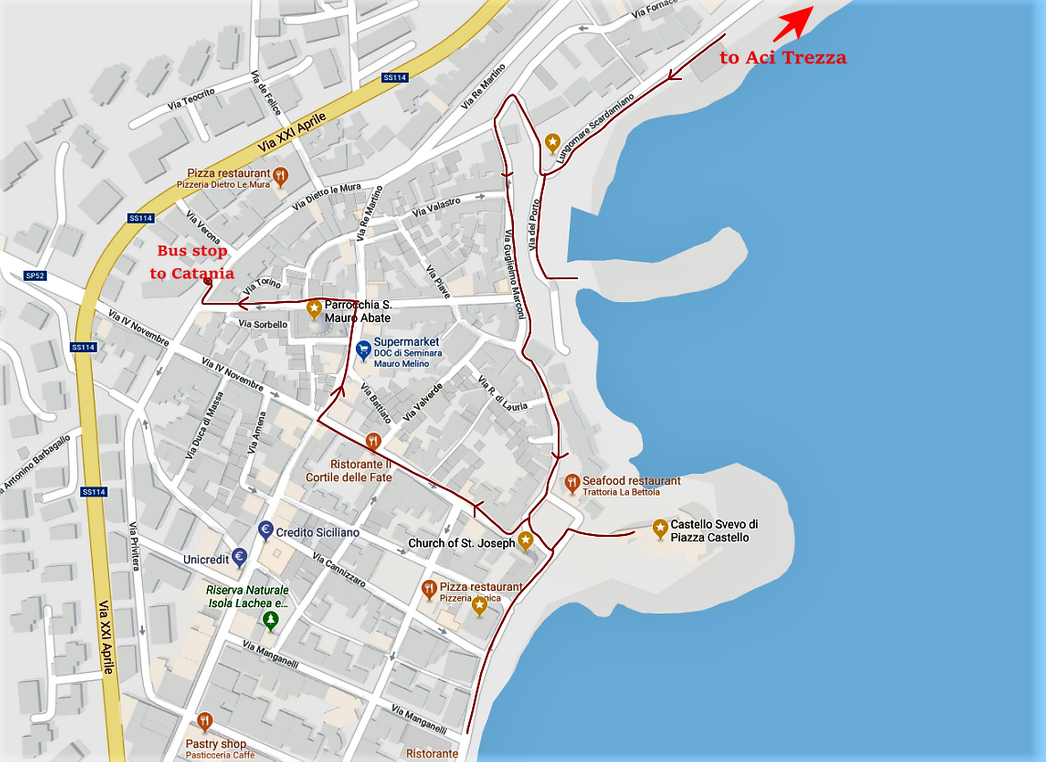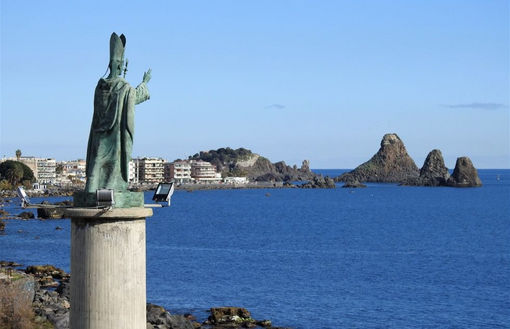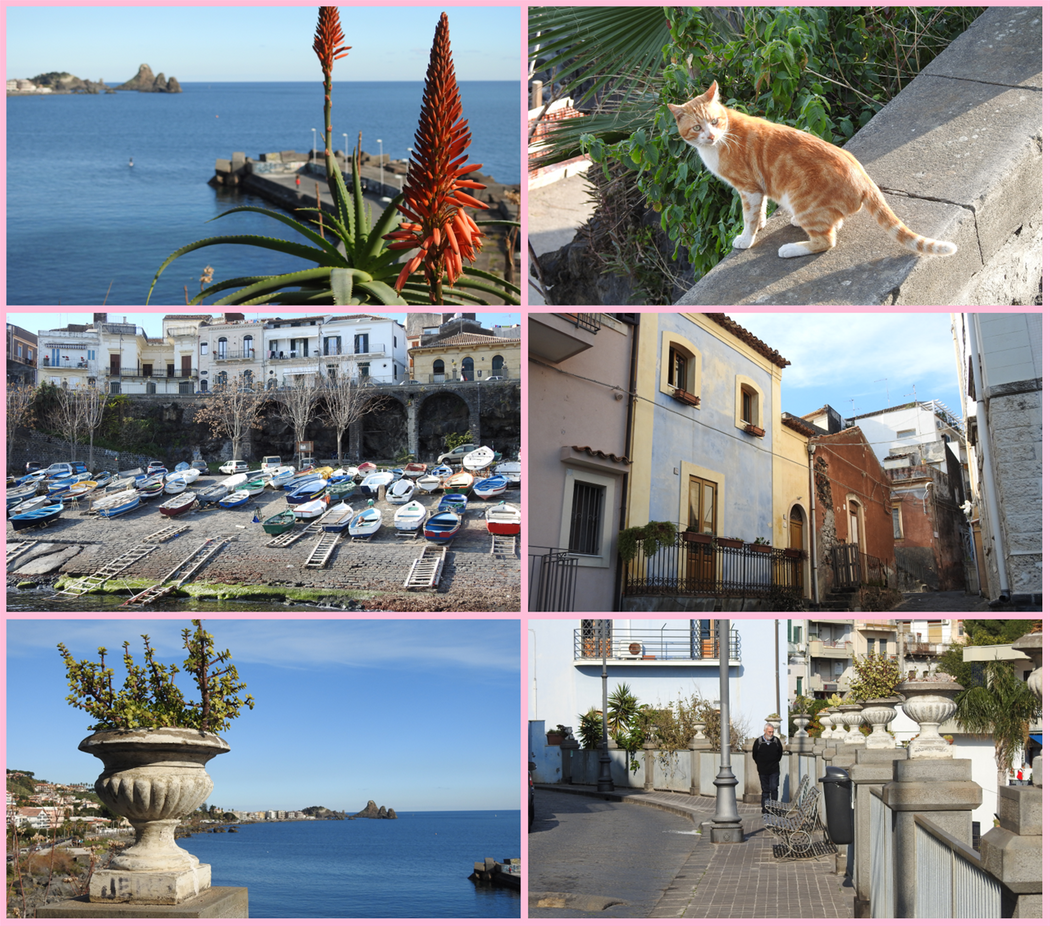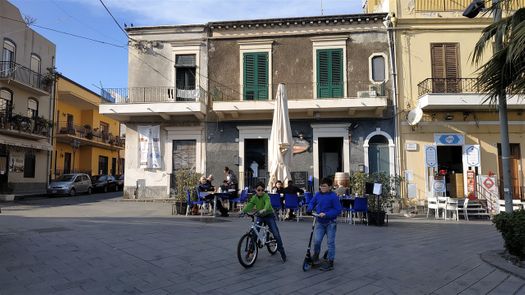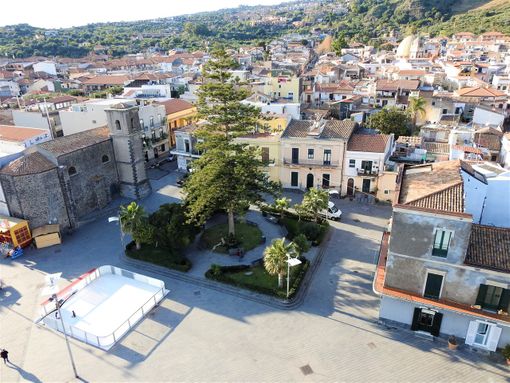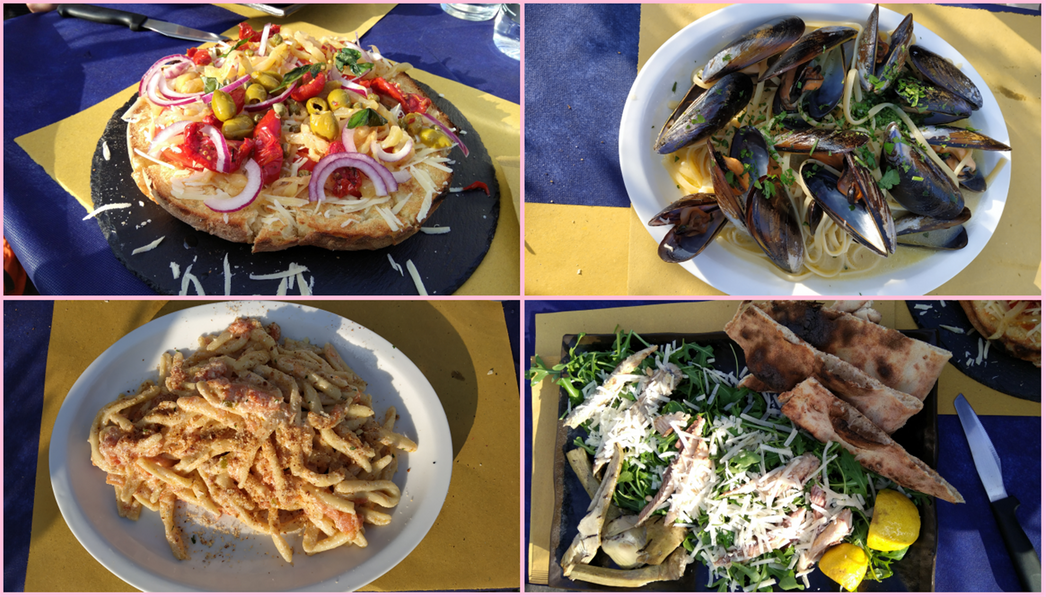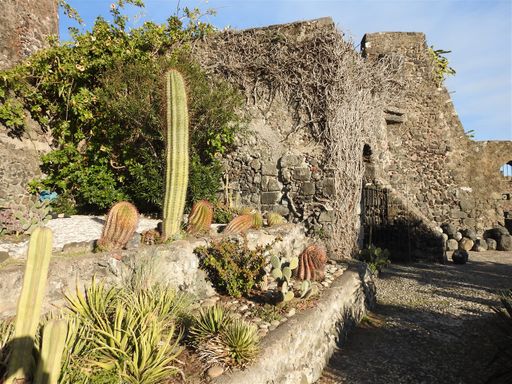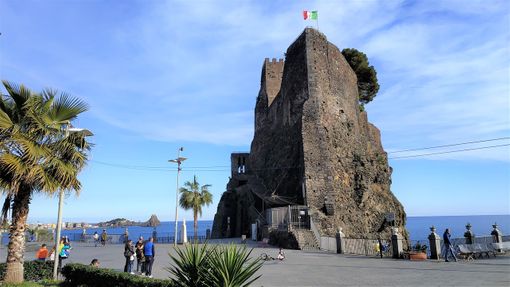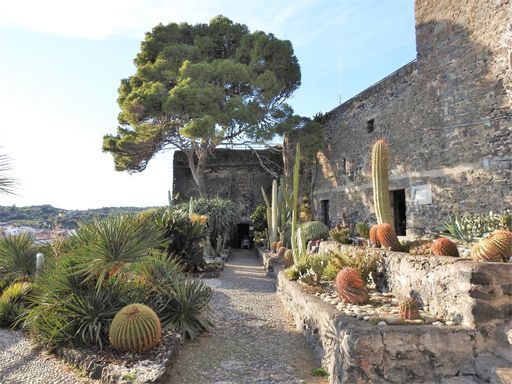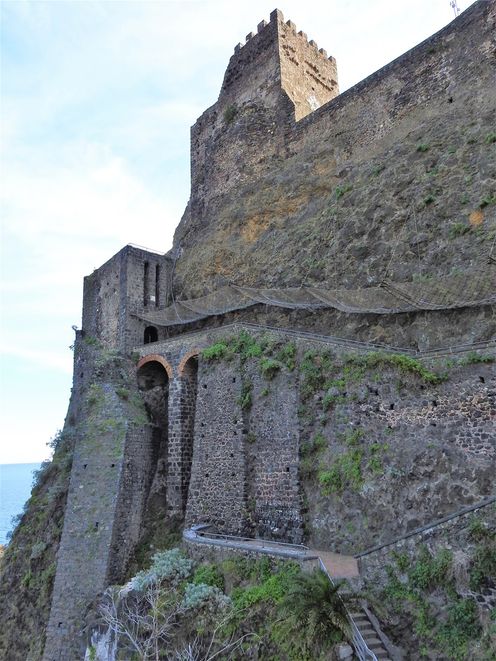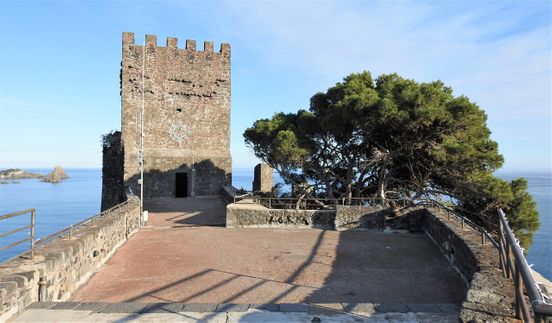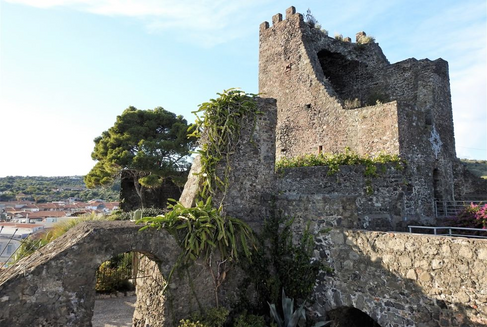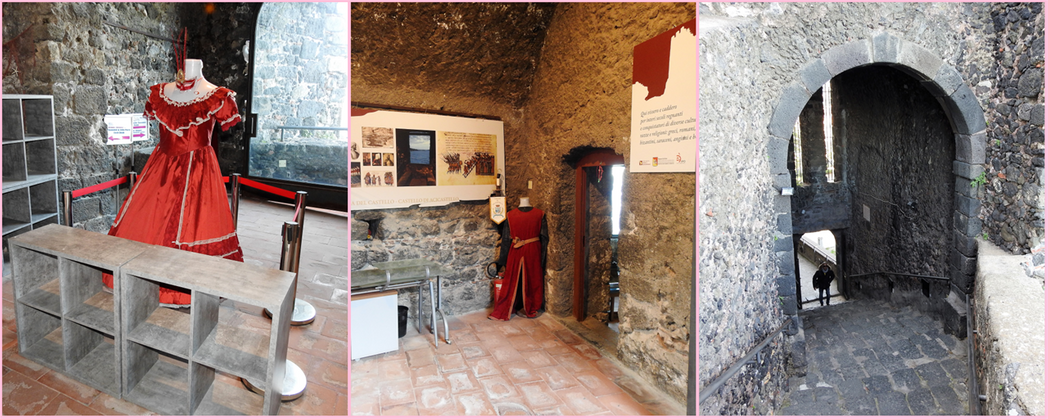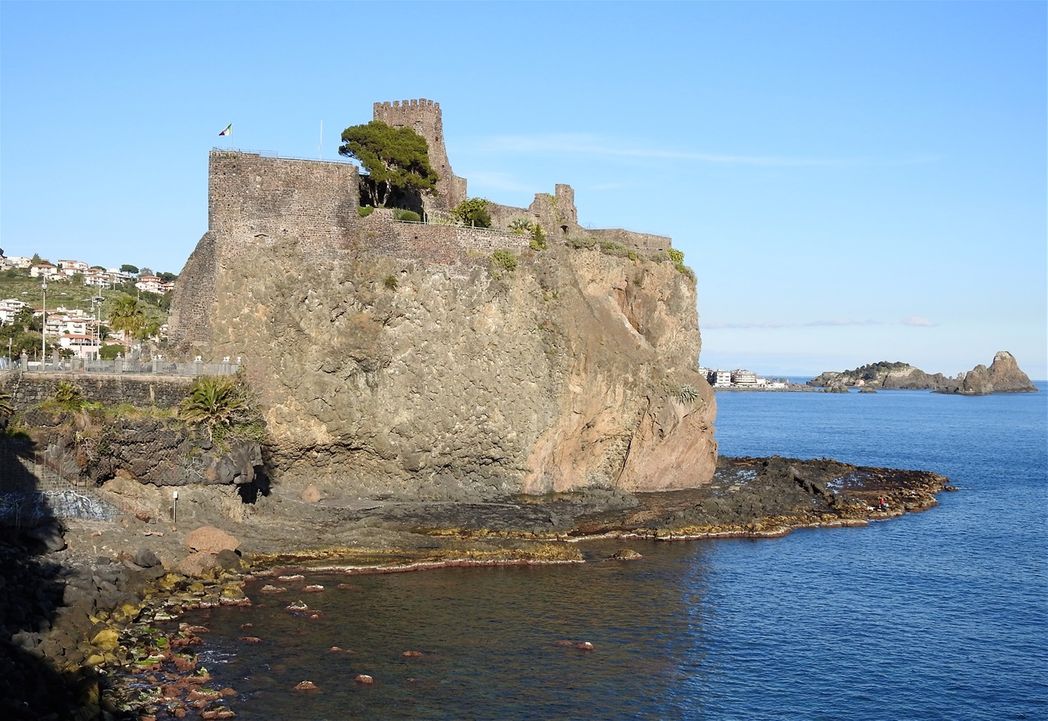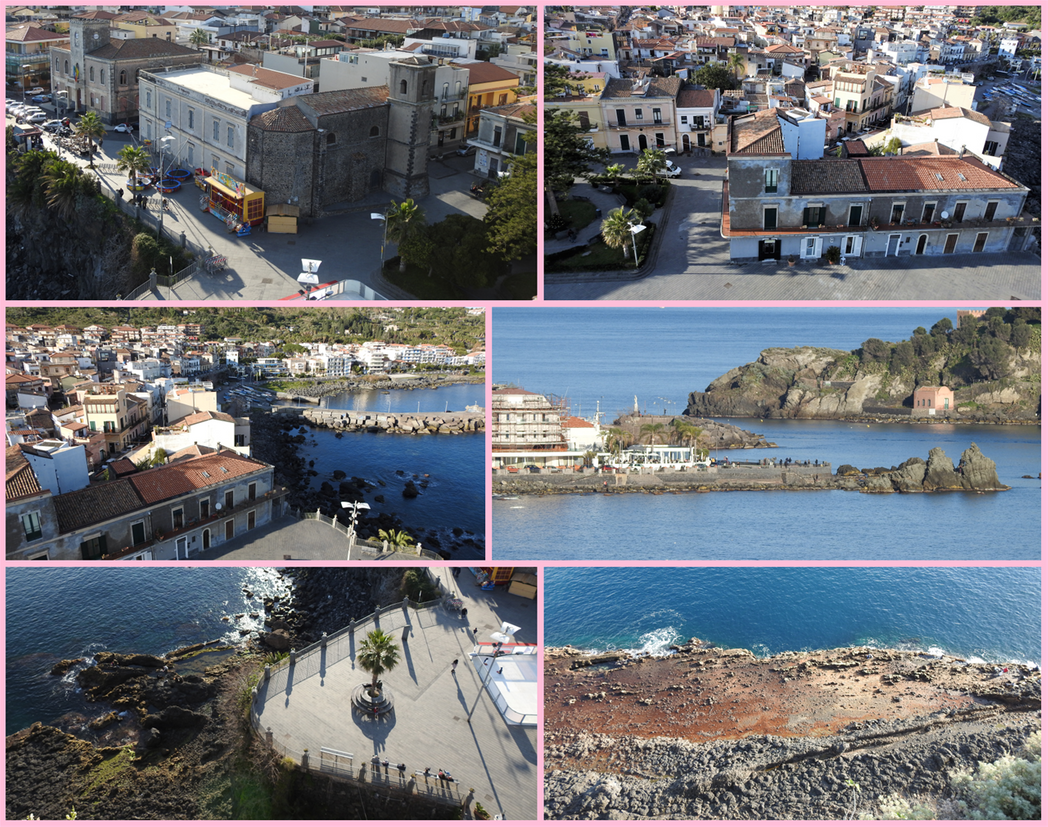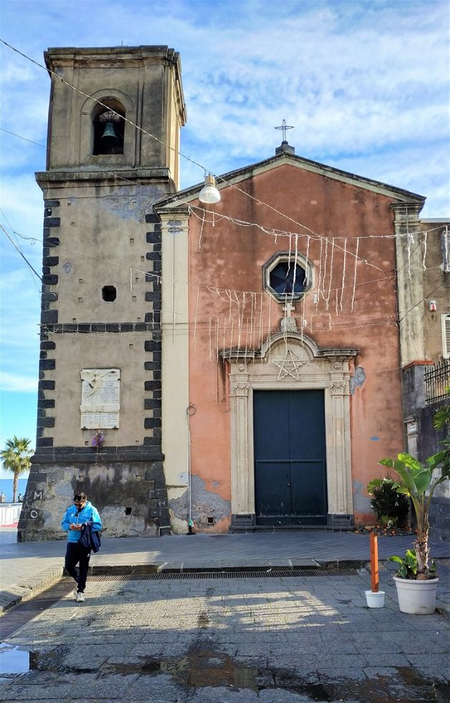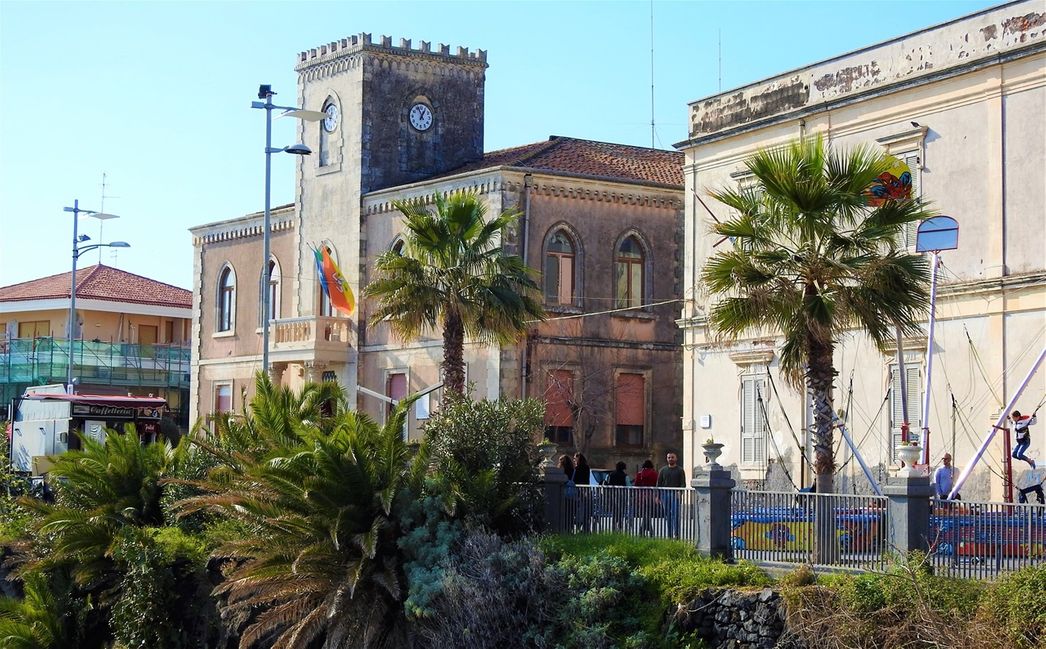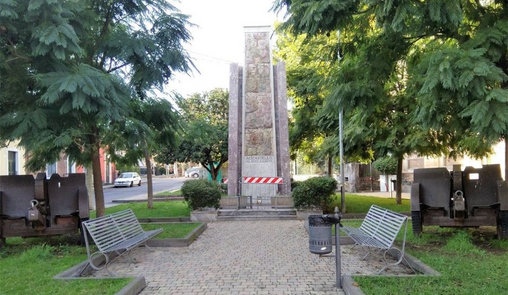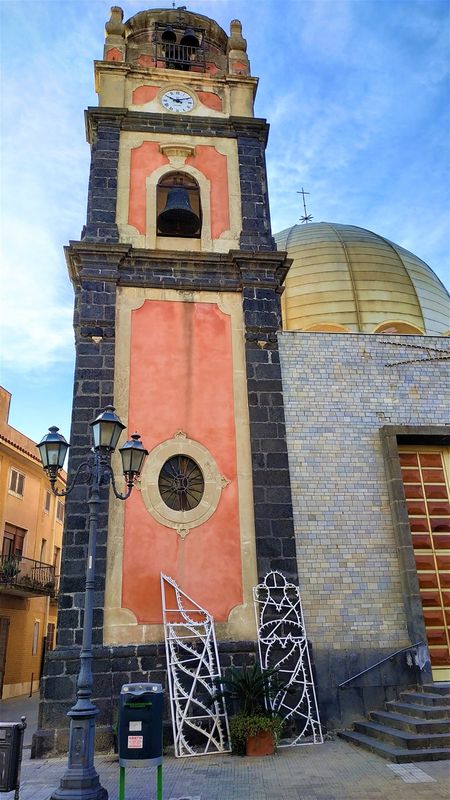Aci Trezza and Aci Castello are two villages on the coast of the Ionian Sea, on the eastern foots of Etna. They are part of a number of villages around the town of Acireale, whose first part of the name consists of the word “Aci”.
Aci Castello and Aci Trezza are located on the Ionian Sea, at the north east of Catania.
The two villages are located only 10 kilometers north of Catania, so as a matter of fact, they are considered suburbs of the city and great escapes for the weekends and popular spots for Italian vacationers in the summer.
Aci Trezza
Intro
Aci Trezza has a long history of maritime activity. The patron Saint of the town is St. John the Baptist (San Giovanni Battista). The Festa of San Giovanni is celebrated each year during the last week of June in his honor. The vault of the church of San Giovanni Battista is decorated with frescoes by the painter Vincenzo Sciuto from Aci San Antonio, which represent the martyrdom of San Giovanni Battista.
Aci Trezza is a popular seaside resort. The principal activity in Aci Trezza is hanging out on the seafront.
History
Aci Trezza has always been a fishing village.
Aci Trezza is a popular seaside resort whose rocky beaches with their dramatic rock formations in the sea are the main draw. The village itself is pretty with its pastel colored houses and the town tends to be at its liveliest on an evening when locals descend from surrounding areas to eat at the popular fish restaurants around the harbor. The principal activity in Aci Trezza is hanging out on the seafront, sunbathing in the day – wooden platforms are set up over the black volcanic rocks – and waltzing up and down after dark.
The history of Aci Trezza is relatively recent, even if the territory is connected to events relating to the mythical Cyclops, Polyphemus and Ulysses. According to studies, in 1639 the community of ‘Aci Sant’Antonio e Filippo’ broke away from “Aci Aquilia”, becoming a feud of the Princes Riggio of Campofiorito. Since Aci Trezza is close to the sea, Princes Riggio created in this area, in front of the “Faraglioni”, a small commercial port. This is how the history of the village started.
Off the coast of Aci Trezza there are three tall, column-shaped volcanic islands. According to local legend, these are the mythical missiles that the blinded Cyclops, Polyphemus (who lived in Etna), is supposed to have thrown at the fleeing Odysseus. The islands are referred to as the “Faraglioni of Trezza” or the "isole dei ciclopi" (islands of the Cyclops).
Isole dei ciclopi.
Isole dei ciclopi
This complements the notion that the Cyclops once had a smithy below Mount Etna, which looms over the village to the northwest. The “Kingdom of Polyphemus” was “a pointed land”, as Ulysses said. While Ulysses was in the cave of the Cyclops the latter asked him to show him his landing place, he answered: "Where your land ends and enters the sea with a ‘big point’" (now called “Capo Mulini”).
Ulysses Deriding Polyphemus is an 1829 oil painting by Joseph Mallord William Turner.
The nature reserve of the “Isola Lachea e Faraglioni dei Ciclopi” was established to protect the fauna and flora of the region. This important reserve includes the Lachea Island and a series of smaller rocks, all of volcanic origin. The Lachea Island, which consists mainly of basaltic rocks, is the largest among the "Island of the Cyclops," and it is linked to the first volcanic eruptions of Etna.
Lachea Island seen from Aci Trezza harbor.
The rich fauna of the waters of the archipelago of the Cyclops includes numerous fishes and invertebrates, and at just a few meters of depth, among the seabed rocks, it is easy to distinguish colonies of sponges, red stars, sea pikes, breams, groupers, seahorses, numb-fishes and lobsters.
Literature and cinema
Giovanni Verga's novel "I Malavoglia" ("The House by the Medlar Tree") is set in Aci Trezza. In 1948, Luchino Visconti filmed his neo-realist film “La terra trema”, based on Verga's novel, in Aci Trezza. The entire cast were local inhabitants rather than professional actors. There is a whole museum in the village dedicated to the film: the Casa del Nespolo is the house described in “I Malavoglia” by G. Verga).
Giovanni Verga's novel "I Malavoglia" editions.
Etymology
The Lachea fauna is also varied and includes some rodents, reptiles and lizards, several species of birds such as the marsh harrier, peregrine falcon, some waders, the Mediterranean herring Gull, peewit gull and the cormorant.
Lachea Island.
The word “Aci” most probably refers to a small river in the area with the same name (Akis). With regard to the "Trezza" part of the place-name (known in Sicilian dialect as "Trizza"), the most prominent theory is that the term means "the place where they worked the braid (“treccia”) cord". This etymology is almost certainly correct, because in this area, in the early 17th century, there were several manufactories run by merchants from Acireale (the town some kilometers to the north), who produced braid cord. According to scholars, "Aci" was added to "Trezza" in the second half of the 17th century.
Aci
With regard to name "Aci", the most common guess is that it derives from the river "Akis", not only mentioned by various Greek and Latin authors but also by Al-Idrisi (1099-1165), the Arab geographer at the Court of the Norman King Roger (1095-1154). Some interesting thoughts on this name was due to an article by G. Libertini published in the early twentieth century, in which he informed us that in the village of Casalotto a stone was discovered with a bilingual (Greek and Latin) inscription, which mentioned a small town named "Akis" (“Aci”). As pointed out by Libertini, the etymology of "Akis" refers to the concept of something that moves forward "fast and straight" or "like an arrow", or in Greek "Akis" (spear, arrow) and "Ake" (point). Thus, the river “Akis” was so named for being as swift as an arrow. However, the question of the etymology of "Akis" is far from a foregone conclusion, as the resolution of this problem includes important historical implications about the origins of the town called "Akis", located on the same river.
Sculptural portrait of Aci and Galatea at Villa Belvedere, Acireale.
Acis and Galatea in myth and music.
Galatea (Γαλάτεια. meaning “milky-white” in Greek), daughter of Nereus and Doris, was a sea-nymph anciently attested in the work of both Homer and Hesiod, where she is described as the fairest and most beloved of the 50 Nereids. In Ovid's Metamorphoses she appears as the beloved of Akis, the son of Faunus and the river-nymph Symaethis, daughter of the River Symaethus. When a jealous rival, the Sicilian Cyclops Polyphemus, killed him with a boulder, Galatea then turned his blood into the Sicilian River Akis, of which he became the spirit. This version of the tale occurs nowhere earlier and may be a fiction invented by Ovid, "suggested by the manner in which the little river springs forth from under a rock".
The Loves of Acis and Galatea by Alexandre Charles Guillemot (1827).
Atis and Galathea by Pompeo Batoni (1761).
According to Athenaeus, ca 200 AD, the story was first concocted by Philoxenus of Cythera as a political satire against the Sicilian tyrant Dionysius I of Syracuse, whose favorite concubine, Galatea, shared her name with the nymph. Others claim the story was invented to explain the presence of a shrine dedicated to Galatea on Mount Etna.
Jean-Baptiste Lully devoted his opera “Acis et Galatée” (1686) to their love. Described by him as a pastoral-heroic work, it depicts a love triangle between the three main characters - Acis, Galatea, and Poliphème. Poliphème murders Acis out of jealousy, but Acis is revived and turned into a river by Neptune. In Italy Giovanni Bononcini's one-act opera Polifemo followed in 1703.
Shortly afterwards George Frideric Handel was working in that country and composed the cantata Aci, Galatea e Polifemo (1708), laying as much emphasis on the part of Polifemo as on the lovers. Written in Italian, Polifemo's deep bass solo Fra l'ombre e gl'orrori (From horrid shades) establishes his character from the start. After Handel's move to England, he gave the story a new treatment in his pastoral opera Acis and Galatea with an English libretto provided by John Gay.
Acis, Galatea, and Polyphemus by François Perrier (1645 and 1650).
Acis and Galatea by Handel.
Initially composed in 1718, the work went through many revisions and was later to be given updated orchestrations by both Mozart and Mendelssohn. As a pastoral work where Polyphemus plays only a minor, though decisive part, it largely centers on the two lovers. In Austria later in the century, Joseph Haydn composed Acide e Galatea (1763). Designed for an imperial wedding, it was given a happier ending centered on the transformation scene after the murder of Acis as the pair declare their undying love.
Aci Castello
Intro
Aci Castello is an ancient seaside village 15 meters above sea level. Its name comes from its castle built in 1076 by the Normans on a lava stone outcrop. The composition of the rock where the building stands is extremely rare and there are few other examples in the world.
It originated from a sea volcanic basaltic eruption more than 500,000 years ago, the lava is covered with a glassy crust (generated by the high temperatures of magma) and it is divided into prisms inside. This particular form and structure is due to the presence of sand and clay in the original sea bed and to the sudden cooling of the magma, caused by contact with cold sea water.
The northern part of Aci Castello.
The castle
The first castle on the site was built in the 7th century by the Byzantines on a pre-existing Roman fortification called Castrum Jacis built to protect the local population from incursions.
In Medieval times it was the focal point of development in the surrounding areas. During the Norman period the first village was founded at the feet of the castle which Count Ruggero then gave to the bishops of Catania. The village was completely destroyed by a terrible earthquake in 1170 and was only rebuilt and inhabited again in 1530, when the nearby villages of Ficarazzi and Aci Trezza were annexed.
Me and the castle of Aci Castello at the background.
Although Aci Castello still conserves its ancient origins, over the years it has become a prestigious seaside resort, attracting large numbers of tourists.
The Piazza Castello and the castle of Aci Castello.
A walk from Aci Trezza to Aci Castello
Getting there
The easiest and the cheapest way to visit the two villages is by a bus from Catania. Bus no 534 (route Catania-Acicastello) connects the city with both Aci Terzza and Aci Castello.
The bus route starts at Piazza Paolo Borsellino in Catania, crosses the city, follows the coast, passes via Aci Castello and terminates at Piazza Delle Scuole in Acitrezza. There are 56 stops and the total trip duration for this route is approximately 38 minutes. The bus is not very frequent, but one can find the closest stop to him and the time the bus passes from the particular stop at the moovit site https://moovitapp.com/ .
One way ticket costs only 1€! Tickets in Catania can be found at any Tabacchi Shop and have to be validated uppon entrance on the bus.
I decided to take the bus all the way to the end of the route, in Aci Trezze, visit the city and then walk by the coast to Aci Castello. Visit Aci Castello and from there to take the bus back to Catania.
The proposed walk in Azi Trezza (red line).
Get off at Piazza Delle Scuole (94 Via Provinciale) and continue on this street towards the north. Via Provinciale is the main commercial street of the village. There are several cafés and restaurants on this street that leads to the main square (Piazza Giovanni Verga) and the church of San Giovanni Battista.
Piazza Giovanni Verga in Aci Trezza.
San Giovanni Battista
San Giovanni Battista is the main church of the village, which rebuilt in 1696, after the earthquake of Val di Noto on 11 January 1693. The Baroque façade of the church, has a classical portal, above which there is a central window and above it a niche with the statue of the patron saint inside. At the top there is a small bell tower and a bell. The main bell tower is in full contact with the southern side of the church. A door on the left of the main entrance of the church leads to a staircase that goes up to the top of the tower and the basic bell.
Aci Trezza celebrates its patron saint in June. The San Giovanni Battista Festa continues for weeks and it is a major event of the area, especially as it takes place during summer holidays and at the peak of the tourist season.
Poster advertising the San Giovanni Battista. The statue of the village patron is celebrated like a rock star!
The square and the church were the backdrop for the film ‘La terra trema’ by Luchino Visconti, entirely shot in Aci Trezza.
Casa del Nespolo
Before reaching the church, at the flight of steps of Via Arciprete Salvatore de Maria (no 15), you come to the entrance to the Casa del Nespolo (the house described in “I Malavoglia” by G. Verga), which contains the museum of the town. This is a typical mid-19th century Sicilian structure. The courtyard contains a small kitchen garden and the main entrance which features a rounded arch in lava stone.
Casa dei Pescatori
At the northern corner of Piazza Giovanni Verga stands a two-storey old building which houses the “Casa dei Pescatori di Aci Trezza”. Fishing is the real soul of Aci Trezza, so much to dedicate a special recreational center to this category of workers. The Casa dei Pescatori is a real meeting place in the heart of the village for fishermen and fishing lovers. Inside it is possible to admire a vast photographic archive.
On the outside wall is hanging a sculpture depicting a scene taken from the novel "I Malavoglia", made in 1939 by the artist Mimmo Lazzaro.
The harbor
The harbor of the village is located down of the Piazza Giovanni Verga. The harbor is offered for a walk among the multicolored fishing boats and the fishermen. At the outer side of the harbor’s breakwater, there are some volcanic rocks the perfect spot for bird watching. Here also stands the fish market of the village (Valpesce Srl).
Aci Trezza harbor.
There are only two rooms inside. The first room called “La terra trema” contains a collection of photographs, posters and other articles regarding Luchino Visconti’s film masterpiece of the same name. The second room “La Stanza dei Malavoglia” (“The Medlar Tree room”), holds a collection of old tools and everyday objects that illustrate the life of the local fishing community in the 19th century. Of great interest are the photos taken by Giovanni Verga in person and a collection of letters sent to his brother Pietro.
The opening hours vary according to the time of the year, but more or less the museum is open every day at 09:30 - 12:30 and 17:00 - 19:00. Entrance costs only 1.5€.
The Entrance to Casa del Nespolo at No15 of Via Arciprete Salvatore de Maria.
The church of San Giovanni Battista. The two-storey old building at the righ end is the “Casa dei Pescatori di Aci Trezza”.
Aci Trezza harbor.
Lungomare dei Ciclopi
From here follow Via Lungomare dei Ciclopi (lungomare= promenade/seafront), which is the coastal promenade, towards the south. At the meeting point of lungomare with Via Fontana Vecchia one can admire some very beautiful and bizarre geological formations: “I basalti colonnari al porto di Aci Trezza”. These basaltic rock formations are protected because of their exotic beauty and geological importance. Columnar basalts are majestic basaltic formations whose presence reveals a submarine volcanic activity. These columns have a pentagonal or hexagonal cross section and can be arranged either horizontally or vertically or even like a fan.
“I basalti colonnari al porto di Aci Trezza”.
Lungomare dei Ciclopi offeres the best views of Isole dei Ciclopi.
Continue on the lungomare and enjoy the best views of the Isole dei Ciclopi while having a drink at one of the cafés here. I stopped for a cappuccino at Mythos Bar and then for a bite at Cafè De Mar. Cafè De Mar is located at the southern bend of the lungomare and has stanning views not only of the Isole dei Ciclopi, but also of the Norman castle of Aci Castello.
Mythos Bar.
Cafè De Mar and the view of the AciCastello castle from there.
In front of Cafè De Mar.
The proposed walk (in red) from Aci Trezza to Aci Castello.
Continue till the end of lungomare and turn right to the last lane that leads back to the main road, which is Via Provinciale and then continue on Via Livorno parallel to the coast. The reason for that is because a private establishment is built on the coast itself and cuts off the public access. One has to walk for about half a kilometer on Via Livorno before turning left again on Via Vadala, following a little stream that goes down to the sea.
Via Livorno. Vegitation is lavish here.
Volcanic seaside rock formations!
From here onwards the walking on Lungomare Scardamiano is without obstacles and the views unique. But, what really makes it worth walking here is the volcanic seaside rock formations! Amazing shapes and colors.
Volcanic seaside rock formations!
The proposed walk in Azi Castello (red line).
After half a kilometer you reach the little fishing harbor bellow the Norman castle. At the pillar with Saint Mauro on top of it (Statua Commemorativa San Mauro Abate), the road goes up to Via Guglielmo Marconi. Via Marconi is elevated and as it swirls following the coastal rock, beautiful vistas of the Ionian Sea open before your eyes. Take some time to get lost into this beauty!
The Statua Commemorativa San Mauro Abate overlooking Isole dei Ciclopi.
Via Guglielmo Marconi.
Piazza Castello
Via Marconi leads directly to the Piazza Castello. This square is probably the best square I have ever seen. It is a real balcony with wide views over the sea interrupted only by the tall figure of the castle, which stands at the eastern edge of it. Around the square, besides the castle, there are a couple of restaurants and cafés, the church of Saint Joseph (Chiesa di San Giuseppe) and the town hall.
“Pizzeria La Luna” at Piazza Castello.
Piazza Castello from above.
I had lunch at the restaurant in front of the church called “Pizzeria La Luna”. Food was is good, but it is the breathtaking views and the "knightly" atmosphere that really matters! We had sicilian bread, which is a flat bread topped with fresh products and delicious home made pasta. Portions were more than generous!
Our lunch at "Pizzeria La Luna". (from top left clockwise) Sicilian bread, linguine vongole, mackerel salad and home made pasta with fresh tomato and almonds.
The Castello
I just did not want to go away from here, so I stayed quite long waiting for the Castle oposite to open again, after the afternoon siesta. Afternoon opening hours vary according to the time of the year: during winter, it opens only for 2 hours from 15:00 to 17:00.
The morning opening hours are the same all year round: 9:30 to 13:00. Entrance fee: 3 euros.
The cacti garden on the castle.
The town’s most striking feature of the square and the village itself is without doubt the Norman Castle, which dominates the Piazza Castello. Its many terraces give wonderful views over the sea below and the Riviera dei Ciclopi.
The castle is inaccessible on three of its sides and the entrance to the fortress is possible only from the square (the west side of the castle) by means of a stone stairway, which at one time had also a wooden drawbridge.
The central part of the fort is a square keep, the ‘donjon’, the heart of the manor. Only a small part of the original structure remains: the entrance with what is left of the drawbridge mechanism; the courtyard which contains a small botanical garden with beautiful cacti; a few rooms including one that houses the museum, a chapel probably dating from the Byzantine period and a wide terrace with wonderful views over the Ionian Sea. The museum is divided into three sections: mineralogy, paleontology and archaeology.
The castle seen from Piazza Castello.
The stone staircase leading to the entrance of the castle (covered with a protective net), and bellow the stairs that take the visitor down to the base of the castle rock.
The very top of the castle.
Inside the castle musem. The entrance of the castle at the top of the stone stairway (right).
Next to entrance to the castle there is a staircase that takes you down at the bottom of the rock on which the castle is build. At the bottom of the rock there is a wide apron of volcanic rocks in beautiful colors.
At the bottom of the castle rock there is a wide apron of volcanic rocks in beautiful colors.
Views from the top of the castle.
Chiesa di San Giuseppe
The parish church (Chiesa di San Giuseppe) on the square is of particular architectural interest with remarkable frescoes by Pietro Vasta (1697-1760). The church of San Giuseppe was built in the first half of the eighteenth century on the site previously occupied by another religious building, as one can guess from the lower section of the bell tower (which has a base typical of the towers of the sixteenth century). The church was dedicated to the Patriarch Saint Joseph, but in addition, the patron saint of fishermen, Saint Francis of Paola, “shares” the church with the former. The church also served as a funerary chapel, because it has a crypt of the same dimensions as the nave, occupied by noble tombs. The church has survived the 1943 allies’ bombardment, but has been destroyed several times by earthquakes, the most recent of which that of 1990. Today it is restored and functional.
Chiesa di San Giuseppe.
The Aci Castello Town Hall overlooks the castle, located just one block away from Chiesa di San Giuseppe.
San Mauro Abate
Take Via Savoia, which starts from just in front of the Chiesa di San Giuseppe to go to Piazza Micale to take the bus back to Catania. But if you have some time, midway there, turn right on Via Re Martino to visit the church of San Mauro Abate. We have no documented information on the first church dedicated to San Mauro in Acicastello, we can, however, suppose that the cult of this Saint, dates back to the Norman Middle Ages.
The present church built at the end of the 16th century or early into the 17th century. We know for sure that the church was seriously damaged by the 1693 earthquake. In 1767, the bell tower were added and began a thirty-year renovation of the church. The church undergone several alternations and renovations till its total destruction during the 1943 bombardments. Only the bell tower survived. The church was rebuilt in 1961 in a modern style, which has caused many criticisms, becuase of its "mosque-like" architecture. Thus, it is nicknamed "the mosque".
San Mauro Abate church.
From Aci Castello there are several stops one can take the bus back to Catania: '68 Via Re Martino', '11 Via Antonino Privitera', '35 Via Cesare Battisti', etc. The most central one, though, is the ‘61 Via Vittorio Veneto’ stop, located at the small Piazza Micale (which is decorated with a memorial column and two canons).

